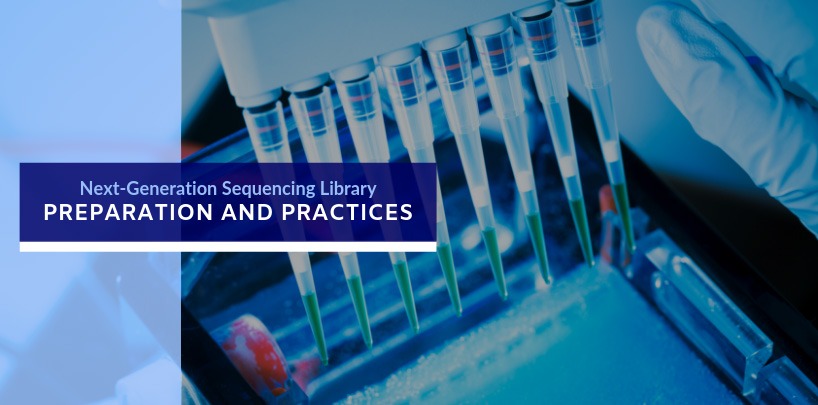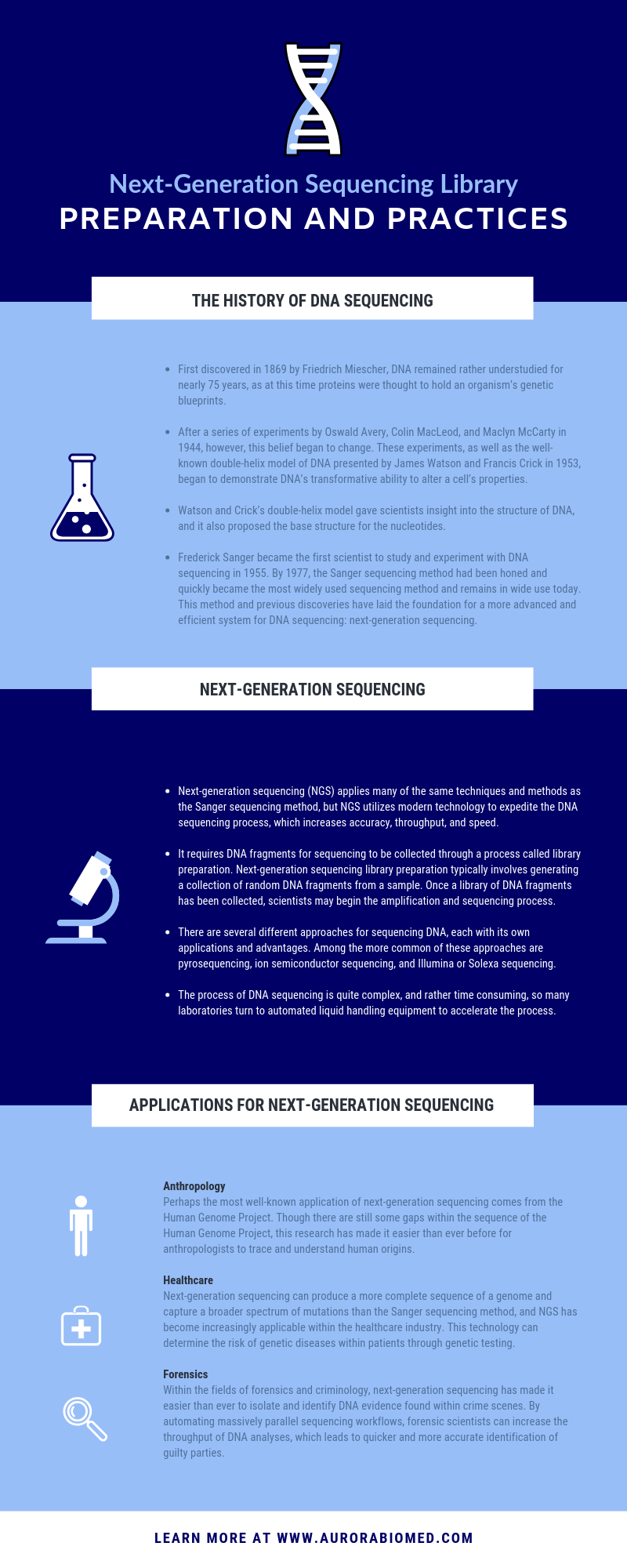
Despite our many individual differences, there is one thing that binds all living beings: DNA. Throughout history, our knowledge of DNA and its impact on many industries has consistently grown. Today, scientists in multiple fields utilize our knowledge of DNA and DNA sequencing technologies to gain insight into who we are as human beings and to create a better future for everyone.
The History of DNA Sequencing
DNA forms the base for all living things, which makes it one of the most important scientific discoveries in history so far; however, our knowledge of DNA’s uses and properties are still relatively new. First discovered in 1869 by Friedrich Miescher, DNA remained rather understudied for nearly 75 years, as at this time proteins were thought to hold an organism’s genetic blueprints. After a series of experiments by Oswald Avery, Colin MacLeod, and Maclyn McCarty in 1944, however, this belief began to change. These experiments, as well as the well-known double-helix model of DNA presented by James Watson and Francis Crick in 1953, began to demonstrate DNA’s transformative ability to alter a cell’s properties. Watson and Crick’s double-helix model gave scientists insight into the structure of DNA, and it also proposed the base structure for the nucleotides within a DNA structure. According to this model, each strand of DNA is composed of four nucleotides, with each nucleotide directly complementing another. Utilizing this model, in which adenine is always paired with thymine, and cytosine is always paired with guanine, scientists gained a better understanding of our genetic composition. This paved the way for further discoveries within the hereditary sciences field.
Building upon the discoveries of Miescher, Avery, Macleod, and McCarty, and Watson and Crick, biochemist Frederick Sanger became the first scientist to study and experiment with DNA sequencing in 1955. The DNA sequencing process took several years to develop, but by 1977, the Sanger sequencing method had been honed and quickly became the most widely used sequencing method—a status it maintained for nearly 40 years. The Sanger sequencing method utilizes a single-stranded DNA template to generate DNA fragments of varying length. Each DNA fragment is terminated with a labeled nucleotide and separated by length. Based upon the length and speed of the separate DNA sequences, scientists could then identify the different bases within a specific DNA sequence. The Sanger sequencing method remains in wide use today, particularly for smaller-scale projects. This method and previous discoveries, however, have laid the foundation for a more advanced and efficient system for DNA sequencing: next-generation sequencing.
Next-Generation Sequencing
Next-generation sequencing (NGS) applies many of the same techniques and methods as the Sanger sequencing method, but NGS utilizes modern technology to expedite the DNA sequencing process, which increases accuracy, throughput, and speed. Next-generation sequencing is a complex process. First, it requires DNA fragments for sequencing to be collected through a process called library preparation. Next-generation sequencing library preparation typically involves generating a collection of random DNA fragments from a sample, and this is done by ligating specialized adaptors to the fragmented ends of a genomic DNA sample. The adaptors allow the complementary ends of fragmented DNA strands to bond together, which creates one complete strand of DNA. Once a library of DNA fragments has been collected, scientists may begin the amplification and sequencing process.
There are several different approaches for sequencing DNA, each with its own applications and advantages. Among the more common of these approaches are pyrosequencing, ion semiconductor sequencing, and Illumina or Solexa sequencing. Pyrosequencing is a technique that utilizes fluorescence to detect pyrophosphate release after nucleotides are incorporated into a new strand of DNA. This technique can sequence much longer reads than other methods. It’s also able to produce results quickly, as this technique utilizes a massive parallel sequencing method in which you can read multiple optical signals simultaneously. Conversely, ion semiconductor sequencing does not utilize optical signals in its sequencing process. Rather, this method detects hydrogen ions that are released during DNA polymerization and builds a complementary strand based upon the DNA sequence of a template strand.
The process of DNA sequencing is quite complex, and rather time consuming, so many laboratories turn to automated liquid handling equipment to accelerate the process. These highly intelligent technologies help reduce the risk of human error during the labor-intensive process of DNA sequencing and library preparation, which allows laboratories to produce a larger number of libraries within a shorter time frame at a lower cost. Automated next-generation sequencing library preparation system (link) is highly scalable and compatible with several additional systems, which allows for effective use across multiple industries and applications.
Applications for Next-Generation Sequencing
Anthropology
Perhaps the most well-known application of next-generation sequencing comes from the Human Genome Project. This international scientific research project sought to identify and map the sequence of base nucleotide pairs that form the human genome. While the genome of each individual is unique, key similarities were used to identify and assemble a complete sequence of chromosomes and produce linkage maps to track inherited traits across generations (link). Though there are still some gaps within the sequence of the Human Genome Project, this research has made it easier than ever before for anthropologists to trace and understand human origins. The research derived from the Human Genome Project enabled scientists to better understand the evolution of humans across time, and has even allowed scientists to trace human origins back to a single population within Africa between 50,000 and 80,000 years ago.
Healthcare
Next-generation sequencing can produce a more complete sequence of a genome and capture a broader spectrum of mutations than the Sanger sequencing method, and NGS has become increasingly applicable within the healthcare industry. This technology can determine the risk of genetic diseases within patients through genetic testing. According to a 2013 study (link), next-generation sequencing can systematically study cancer genomes in their entirety, which can help provide a more accurate diagnosis and classification of the disease. This can help medical professionals provide patients with more individualized treatment and management plans personalized for their specific diagnosis.
Forensics
Within the fields of forensics and criminology, next-generation sequencing has made it easier than ever to isolate and identify DNA evidence found within crime scenes. By automating massively parallel sequencing workflows, forensic scientists can increase the throughput of DNA analyses, which leads to quicker and more accurate identification of guilty parties. This innovative technology is particularly useful in processing unsolved cases. With the aid of expansive next-generation sequencing libraries, forensic scientists can identify single variations within a genome. Based upon a single DNA sample, next-generation sequencing is even able to trace ancestry and predict phenotypes, including hair and eye color.
While DNA sequencing technology has made impressive strides since its development in the late 1900s, there are still many discoveries yet to be made. With the use and continued innovation in next-generation sequencing library preparation and the automation of DNA sequencing workflows, there is no telling what discoveries will be made in the future.



